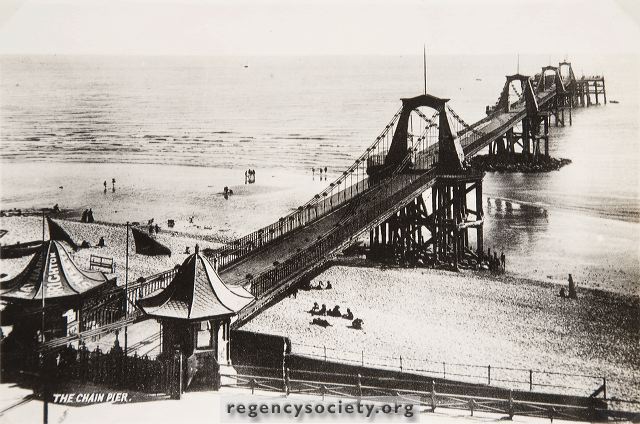I have a massive fascination for the Chain Pier. No idea why, just one of those things I guess. I would love someone to rebuild it one day. For years I heard at very low tide its remains could still be seen, but never quite got around to go and look for them. In September 2009 I decided to go on a hunt for them after studying many photos to make sure I'd got the right location. I was so excited when I found them (I know, weird!).
The Chain Pier was built in 1823 by Captain Samuel Brown. Originally built as a landing stage for package boats to Dieppe. It was a popular promenade with a camera obscura. Also still existing somewhere is the sundial, seen in some of the pictures of the Chain Pier.
The Chain Pier was due to be pulled down after the building of the Palace Pier, however there was a huge storm in December 1896 which completely destroyed the Chain pier. The toll booths from the Chain Pier were saved and placed on the new Palace Pier, as was the cannon from the Chain Pier.
As I couldn't possibly have been there to take this photograph myself. Here is a photo of what the Chain Pier looked like.

Many thanks to the Regency Society for the use of this photograph.
The James Gray Collection is the photographic archive of
the Regency Society. www.regencysociety-jamesgray.
At the time I didn't appreciate how lucky I was to catch such a low tide. These remains are not often visible as I have been back since and they have been covered over. So here they are , the remains of the Chain pier. 1823-1896. R.I.P!
Photographed in September 2009. Just a mere 113 years later.
Three Piers
For a brief moment in time Brighton had three piers. The Chain Pier, the West Pier and the Palace Pier. The Palace pier was built to replace the Chain pier and the building of it started in 1891 five years before the Chain Pier finally collapsed. A lot of people think it was built in the same location as the Chain Pier when infact the Palace Pier was built slightly to the West of the Chain Pier about two beaches apart.
The picture here shows the remains of the Chain pier and the surviving Palace pier and remains of the West Pier in the background. September 2009.
The remains of the second set of pylons of the Chain pier in the sand looking towards the arches in the wall behind where the chains would have been embedded. Beyond that is New Steine.
September 2009.
A view looking towards New Steine from the second set of pillars.
September 2009.
The tips of the remaining stumps from the third set of pillars of the Chain Pier, just visible above the water. The fourth set were just visible also.
September 2009.
Not the best of photographs but a relevant one. In the water can be seen the tops of the remains of the third set of pylons of the Chain pier. The remains under water are visible on google earth if you have a look.
September 2009.
Remains of the second set of pillars from the Chain pier.
September 2009.
A close up of one of the stumps from the second set of pillars .
September 2009.
A close up of the remaining stumps from the second set of pillars.
September 2009.
The signal cannon from the Chain Pier. Now to be found towards the end of the Palace Pier.
December 2011.
The commemorative plaque for the Chain Pier.
December 2011.
This is where the chains from the Chain Pier were embedded into the East cliff.
December 2011.
One of the two remaining toll booths from the Chain Pier. Now in place on the Palace Pier.
2009.
Chain Pier House. Marine Parade.
The Chain Pier's Engineer, Captain Samuel Brown apparently stayed here during the construction of the pier.
2012.
Believed to be the sundial which once sat at the end of the Chain Pier in a fenced off area. Now rotting on a grave in a churchyard in Sussex. The base is missing but the pieces on the floor to the left are the top of the sundial
April 2012
February 2016
I havent seen the remains visible for a few years but was very glad to see them on show again this February. One of the lowest tides of the year.
April 8th 2016.
One of the years lowest tides. Sadly the remains at the shoreline weren't visible but the tide was so low you could see many of the remains of the third set of piles.